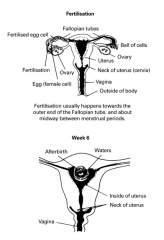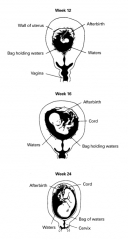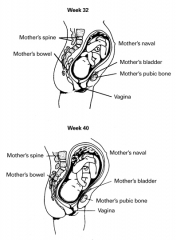Topic 2: Progress of Pregnancy
A missed period is usually the first clue you may be pregnant. The medical term for this is amenorrhoea. However, some women who are pregnant have a very slight period, losing just a little blood.
Changes in your breasts
Your breasts may become bigger and feel tender. You may feel a prickling, tingling sensation in them. The veins may show up more and nipples may darken.
Nausea
Feelings of nausea are common in the morning just after you get out of bed, but they can happen at any time of the day. For advice on coping with morning sickness, see Morning Sickness.
Fatigue
You have feelings of fatigue.
Frequent urination
Needing to urinate more often is normal during pregnancy. However, if there is any pain on passing urine, see your doctor immediately.
Constipation
Symptoms of constipations include a reduction in the frequency of bowel motions, and pain or difficulty in emptying your bowel. Stools are usually hard and small. Talk to your doctor or healthcare professional about prevention of constipation.
Changes in your genitals
Two or three weeks after a missed period, you may notice changes in your genitals. The external genitals become bluish in colour. The vagina feels moist and you may have more vaginal discharge.
As the egg moves down the Fallopian tube, it divides into two cells. The cells keep dividing until a solid ball of cells has been formed. When it reaches the uterus, this ball of cells attaches to the wall of the uterus. Once the ball of cells is attached, the tissue surrounding it produces hormones which help the pregnancy to continue. This happens before your next period is due, and stops the bleeding. However, you may still get a light period or, less likely, what appears to be a normal period.
The outgrowth of cells which develops into the baby is referred to as the embryo at this stage. That part of the ball of cells which attaches to the wall of the uterus becomes three things—the umbilical cord, the placenta and the amniotic sac.
The placenta absorbs oxygen and nourishment (as well as nicotine and other drugs) from your blood and these are carried to the baby by your cord. Waste materials from the baby are carried back by the cord to the placenta and are disposed of by your body.
The amniotic sac is filled with fluid which protects the baby while it is in the uterus.
Week 6
At six weeks, the embryo is about 5mm long, from its head to its bottom, or a bit smaller than your little fingernail. Its brain, stomach and intestines are developing and the heart is starting to beat. Little dimples on the head mark where the eyes and ears will be. Arms and legs are starting to “bud”.
Week 8 – 9
At 8 – 9 weeks, a face is forming, the eyes and ears are developing and the embryo has a mouth and tongue. The heart, brain, lungs, kidneys, liver and intestines are all developing. Limbs are growing and the hands show signs of fingers.
Week 12
At 12 weeks, the embryo is now called a foetus. It is about 5cm long, from its head to its bottom, or about the size of your little finger. It has a nose and a neck, and all its organs and parts have been formed, including ovaries or testicles. From now on, the foetus grows and parts of its body mature.
Week 16
At 16 weeks, the foetus is about 10cm long, from its head to its bottom, or about the size of your palm. At 16 – 20 weeks, you feel the foetus move (it feels like fluttering). The top of you uterus is about level with your navel.
Week 24
At 24 weeks, the foetus is about 21cm long, from its head to its bottom, or about the length from your elbow to your wrist.
Week 32
At 32 weeks, the foetus is about 25cm long, from its head to its bottom, or about the length from your elbow to the base of your fingers.
Week 40
At 40 weeks, your baby is about 33cm long, from its head to its bottom, or about the length from your elbow to the tips of your fingers. Your uterus has increased in size to almost fill your abdomen. You are said to be “at term” and your baby is ready to be born.
Sound
The baby can hear the thud of its mothers heart and the grumble of air passing in her intestine. However, although the baby is used to noise, it will still react to a loud noise outside the uterus by moving.
Once the baby is born, being held on the left breast is often more calming than being held on the right. This is probably because the baby can hear the mother’s heartbeat—the familiar sound it heard in the uterus.
Touch
Once the hands and feet are formed, the baby can touch other parts of its body with them. Early in the pregnancy, the baby needs to move away from anything it touches; later on, it moves towards it. If a finger gets into its mouth, the baby will suck it.
Movement
Although you do not usually feel movement until the 16th to the 20th week, the baby actually begins moving in the ninth week. Some movements happen in the regular pattern which may be related to when the baby sleeps. The baby tends to be more active if you are stressed, tired or have recently had a meal.
Pain
The baby’s heart rate and movement increases if it is touched (this may happen during amniocentesis) but will return to normal within a few minutes.
Pregnancy ends and labour begins about 280 days after the first day of your last period. One way to estimate your expected date of delivery is to add seven days to the date of the first day of your last menstrual period. Count forward nine months, and you have the Expected Date of Confinement (ED).
Example:
Your last period started on 7th April. Add seven days: 14th April.
Count forward nine months: 14th May, 14th June …
Your baby is due about 14th January.
For ease of calculation, see our Obstetric Table
This is a convention that has been used for a long time, but some people find it confusing. If you have a menstrual cycle that is shorter or longer than 28 days, your doctor or healthcare professional may change the EDC from what was worked out using the date of your last period.
If labour starts early, before the end of the 37th week, the baby is “pre-term” and may have problems and require special care in the early days or weeks after birth. If pregnancy lasts more than 42 weeks, the baby is “postdates”. Unexplained problems are more common after this time. This is why it is important to know the date of your last period.
If you are in any doubt, tell your doctor or healthcare professional at your first antenatal visit. Your doctor or healthcare professional can estimate the delivery by monitoring the growth of the baby in the uterus, conducting an internal examination or an ultrasound.
Identical twins result from one fertilised egg splitting into two separate cells. Each cell then develops into a baby. Because they have come from the same egg, the babies have the same genes. They are the same sex and they look very alike. Identical twins usually share one placenta but have separate cords. Non-identical (fraternal) twins develop when two eggs are fertilised by two sperm. They will resemble each other only as other brothers and sisters do. Each twin has its own placenta.
Triplets are rare and quads (four babies) are rarer still, although the use of fertility drugs is making multiple births more common.
Signs that may indicate a multiple pregnancy include fast weight gain or a uterus that is larger than usual for your particular stage of pregnancy, or exaggerated nausea, or urinary frequency. In the later pregnancy, the doctor may be able to feel the head, back or limbs of more than one baby. Sometimes, an ultrasound is needed to confirm a multiple birth.









